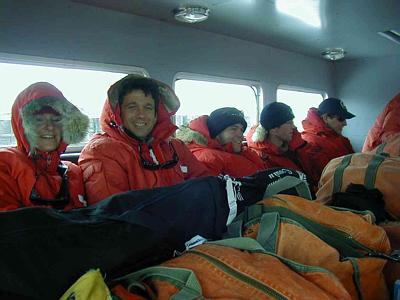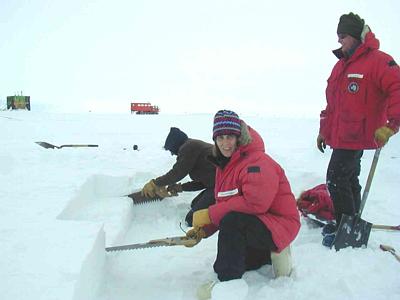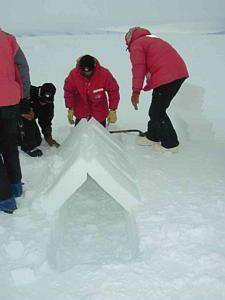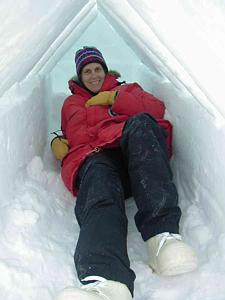12 November, 1999
Ross Ice Shelf, Antarctica Friday
Today we prepared for Snow Craft I, better known as, Snow Survival School,
or Happy Camper School! Before departing to the Ice Shelf, we discussed
hypothermia and frostbite and were instructed regarding proper clothing and
how to dress during this exercise. There were 22 of us, quite a large
group. Over half of the group (12) were Kiwi military (from New Zealand's
Army, Navy, and Air Force). They are working at McMurdo for the season as
cargo-handlers (cargo-ologist, as they say). Our group brought the number
to 17. There were a few support staff personnel and a couple of other
scientists.
After the initial lecture, we boarded a vehicle called a Nodwell. The
Nodwell is a tracked vehicle that can negotiate large snowdrifts. Look for
it in the photos that I have included with this journal. The drive to the
Ross Ice Shelf took about 30 minutes. When we arrived, we learned how to
operate the camp stoves, we ate lunch and began our walk to the camp site.
At the camp site, the instructors quickly pointed out that there was an
outhouse for the women (there were 5 of us) and a yellow flag for the men!
The outhouse was a 12 foot pit dug in the snow! BRRRRR!
At the camp site, we were split into two teams. My team consisted of Mark
and Bess from my research group, 6 of the Kiwi military, and 3 other
fellows. Immediately, we set about putting up Scott tents (also known as
polar tents). These tents are constructed of heavy canvas and are designed
to be able to be erected in high winds. The door to the tent is a small
tunnel that keeps out the wind. There is a vent at the top so that a small
stove can be used inside. The Scott tent can accommodate four people
comfortably. We learned how to tie down a tent in snow. This is different
than planting stakes in the ground. Paul and Murray, two Kiwi military,
taught me now to tie special knots to hold the tent in place.
Next we put up smaller alpine tents designed for backpackers. These tents
are lightweight and compact. They sleep two. Bess and I shared a tent.
It's important to get your shelters ready first in case the weather worsens.
After putting up the tents we went about building a wall to protect the
tents from the fierce wind that was picking up. This required cutting
blocks of snow and actually building a wall! It was hard work! Everyone
pitched in and helped in building the wall. We worked so efficiently that
we had time to build a second wall for our 'kitchen'. Once the walls were
in place, some of the Kiwi fellows built a trench shelter. This is also
called 'the grave that saves'. Look at the photo's and you will understand
why it is referred to as a grave! When I crawled into this structure, it
was warm and cozy! I wanted to sleep here but, the instructor marveling at
how well the trench was built, decided that he should sleep in it!
We boiled water in our kitchen and cooked freeze-dried meals, eating right
out of the bag! Some of the food items included fettuccini, chili, mushroom
pilaf, and chicken stroganoff. We also had granola, beef jerky, lots of hot
drink items like coffee, tea, and cocoa, and many candy bars! We had been
told how important it was to eat and drink to avoid hypothermia and we took
them at their word!
After walking for a few miles to a crevasse that had formed in the snow and
ice, we settled in for some conversation and then to bed at 11 p.m. I
commented on our ability to accomplish much when true teamwork is applied.
Having soldiers on my team was a plus. They instinctively knew how to work
together and were quite adept at knowing what had to be done without asking.
I was impressed with their willingness to show us tricks of survival that
they had learned in their own military exercises. And, when my hands got
cold, two soldiers kindly gave me handwarmers!
Answer to yesterday's question: I don't have an answer for you yet! We'll
learn all about this tomorrow!
Sharon
JUST FOR KIDS!!!!! Today we had Snow Survival School! This is also known
as Happy Camper School! We learned how to put up tents in a snowstorm and
how to light the camp stove. We cut blocks from the snow and built two
walls to protect us from the fierce winds that were blowing all night! We
were camping on the Ross Ice Shelf. Get a map and see if you can find it!
Some of the fellows that were camping with me taught me now to tie knots!
This is very hard to do when your fingers are cold! It is also very
important! Without proper knots, your tent could blow away!
We boiled water in our 'kitchen' and made our suppers. We ate right out of
the bags that the suppers came in! After taking a very long walk, we
settled into our sleeping bags for a long, cold night!
Answer to yesterday's question: I don't have an answer for you yet! We'll
learn all about this tomorrow!
Sharon

Julie and Mark riding to Snow Survival School on the Nodwell

Sharon cutting snow blocks for the wind wall. I was beginning to sweat! This was hard work!

Constructing the snow trench or 'grave that saves'. This is a hole in the snow with a covering of snow blocks for wind protection.

Sharon in the trench. It was warm and cozy!
Contact the TEA in the field at
.
If you cannot connect through your browser, copy the
TEA's e-mail address in the "To:" line of
your favorite e-mail package.
|
